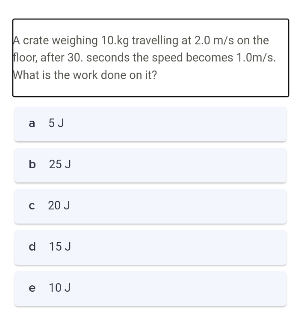A crate weighing 10 kg travelling at 2.0 m/s on the floor, after 30 seconds the speed becomes 1.0 m/s. What is the work done on it?

Understand the Problem
The question is asking to calculate the work done on a crate that decelerates from an initial speed to a final speed over a certain period of time. The key concepts include mass, initial and final velocity, and the work-energy principle.
Answer
The work done on the crate is $-15 \, \text{J}$.
Answer for screen readers
The work done on the crate is $-15 , \text{J}$.
Steps to Solve
- Identify the given values
The mass of the crate, $m = 10 , \text{kg}$, the initial velocity, $v_i = 2.0 , \text{m/s}$, and the final velocity, $v_f = 1.0 , \text{m/s}$.
- Calculate the initial and final kinetic energy
The kinetic energy (KE) is calculated using the formula:
$$ KE = \frac{1}{2} mv^2 $$
Calculating the initial kinetic energy:
$$ KE_i = \frac{1}{2} \times 10 \times (2.0)^2 = \frac{1}{2} \times 10 \times 4 = 20 , \text{J} $$
Calculating the final kinetic energy:
$$ KE_f = \frac{1}{2} \times 10 \times (1.0)^2 = \frac{1}{2} \times 10 \times 1 = 5 , \text{J} $$
- Calculate the work done on the crate
The work done (W) is the change in kinetic energy:
$$ W = KE_f - KE_i $$
Substituting the values we calculated:
$$ W = 5 , \text{J} - 20 , \text{J} = -15 , \text{J} $$
Since the work done is negative, this indicates that energy was taken out of the system (deceleration).
The work done on the crate is $-15 , \text{J}$.
More Information
The work-energy principle states that the work done on an object is equal to the change in its kinetic energy. In this case, a negative work value indicates that the crate was slowed down.
Tips
- Ignoring the minus sign: It's important to recognize when work is negative, as it indicates energy removal from the system.
- Miscalculating kinetic energy: Double-check the calculations for both initial and final kinetic energy.
AI-generated content may contain errors. Please verify critical information